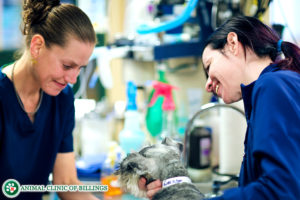Iliopsoas muscle strains and tears
What is the iliopsoas and what does it do?
The iliopsoas muscle is a paired muscle that extends from the vertebrae of the low back and the pelvis to the upper portion of the femur (thigh bone). This muscle functions to flex the hip joint.
What causes injury to the iliopsoas muscle?
Iliopsoas strains and tears are relatively common and generally under-recognized in dogs. They most frequently occur following intense physical activity, such as agility training or vigorous play with other dogs, or from sudden powerful muscle contraction, such as that experienced when slipping on ice or loose footing. Iliopsoas injuries can also occur as a result of attempts to compensate for another orthopedic abnormality, such as hip dysplasia or a torn ACL.
How is iliopsoas injury diagnosed?
Dogs that have an iliopsoas injury usually exhibit a short, shuffling gait in their back legs due to discomfort during hip extension, which stretches the iliopsoas muscle. They are usually hesitant to go up stairs or jump up onto things, as these movements require hip extension. Lameness can range from mild to severe, may come and go, and may involve either one or both hind limbs. Usually, lameness gets worse with exercise.
On physical exam, patients with iliopsoas injuries will be painful on extension of the hip with abduction or internal rotation of the limb. They are also very sensitive to direct pressure over the iliopsoas muscle. Ultrasound of the injured iliopsoas muscle typically reveals disruption of normal muscle fiber organization as well as edema (inflammatory fluid). MRI is also very useful for imaging the iliopsoas, but is usually not necessary for diagnosis.
How are iliopsoas Injuries Treated?
Acute iliopsoas injuries are treated with a combination of medications and physical rehabilitation therapy. Usually, a combination of a non-steroidal anti-inflammatory and a muscle relaxant is prescribed. Physical rehabilitation measures initially include ice, laser therapy (to improve circulation and aid in healing), passive range of motion exercises, core strengthening exercises, and active weight-bearing exercises. As healing progresses, heat therapy, strengthening exercises, and active range of motion exercises are added. In most cases, an acute strain or partial tear will heal within 4-8 weeks with these measures.
Chronic Iliopsoas strains and tears are treated similarly to acute injuries, with a few major differences. Heat, massage, and stretching are initiated earlier in the rehabilitation protocol, and more emphasis is placed on improving strength, endurance, and flexibility with active exercises. Therapeutic ultrasound is often also incorporated. Chronic injuries usually take longer to heal than acute injuries, and it would not be unusual for this process to take several months or more.
In cases that have failed to respond to appropriate medical management and physical rehabilitation, or that have evidence of irreversible damage (such as a large amount of scar tissue), surgery is indicated. Surgical treatment of intractable iliopsoas injuries involves severing the tendon that attaches the muscle to the femur (thigh bone).
What is the prognosis for an iliopsoas injury?
While it can take an extended period of time, the vast majority of iliopsoas injuries successfully respond to medical management and physical rehabilitation therapy, allowing for a return to full activity. The prognosis following surgery is also very good, although it is recommended that dogs that have undergone surgery do not engage in physical activity with the intensity that they did prior to their injury, in order to reduce the risk of future injury to other structures in the hip area.
A number of interventions may aid in reducing the risk of recurrence of an iliopsoas injury. A low-impact and low-intensity warm-up, followed by stretching of the muscles around the hip, should be performed prior to any intense physical activity, such as playing fetch or doing agility work. A low-impact cool-down, followed by icing the groin area for 5-10 minutes, should follow such activities.
Some dogs with recurrent iliopsoas injuries may need to have their activity level permanently restricted to avoid movements that cause repeated damage and the return of symptoms. Activities that have the greatest risk of causing re-injury include playing fetch or Frisbee, chasing wildlife, and jumping (especially in and out of cars). Because slipping on hardwood or tile floors is also likely to result in re-injury (especially in older pets), it can be helpful to add rugs or carpet runners to areas they frequent to provide better footing. Dog booties with traction soles can also be used to help reduce the risk of slipping accidents.
There are a variety of treatment options available at the Animal Clinic of Billings and Animal Surgery Clinic that can bring relief to sore and injured pets. If your pet shows any signs of lameness or discomfort, please call us to schedule an appointment with one of our veterinarians.
406-252-9499

Let our highly trained and experienced team of veterinarians and veterinary technicians help you keep your cat as happy and healthy as they can be.
Call the Animal Clinic of Billings and Animal Surgery Clinic to schedule your pet cat’s next wellness examination with one of our veterinarians today!
406-252-9499 REQUEST AN APPOINTMENT
ANIMAL CLINIC OF BILLINGS AND ANIMAL SURGERY CLINIC
providing our region’s companion animals and their families what they need and deserve since 1981
1414 10th St. West, Billings MT 59102
406-252-9499



